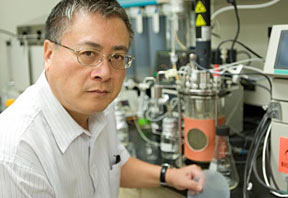Byproducts become biodegradable plastic
January 4th, 2011 | by Malamalama Contributor | Published in Jan. 2011 | 4 Comments

Jian Yu in lab holding bioplastic
A University of Hawaiʻi at Mānoa research team is turning agricultural byproducts into a new generation of biodegradable plastics that could be made in the state.
“We hope the plastics we are developing will significantly improve the global environment at costs that are competitive with or less than traditional petrochemical plastics,” says Jian Yu, a Hawaiʻi Natural Energy Institute associate researcher who heads the bioplastics research team.
Yu has filed for two patents based on the processes he developed. The technology is being used in a pilot plant in Europe, and the company that operates it plans to invest $2 million to establish a biomaterial testing laboratory in Hawaiʻi.
As an island state, Hawaiʻi has a vested interest. The archipelago receives a barrage of plastic waste that escapes the vast ocean gyre known as the Great Pacific Garbage Patch. Debris that doesn’t kill birds, fish, seals and turtles outright breaks down into smaller pieces, introducing toxic petrochemicals into the global food chain.
The concept of biodegradable plastics dates to the 1970s. Producers used chemical synthesis to blend conventional plastics with a natural product, like starch.
“Unfortunately, the starches only enhanced fragmentation, making it easier for these petro-plastics to enter the food chain,” says Yu. Later attempts used PLA (polylactide) polymers derived from corn and other plant sugars to make rigid transparent containers. The polymers break down at the relatively high temperature in municipal landfills, but not in the natural environment.
Yu’s PHA (polyhydroxyalkanoate) plastics are formed by biological activities in microbial cells without chemical synthesis. Common bacteria easily break down the resulting product into carbon dioxide and methane gas in the presence of water.
“You could literally dump this plastic into the ocean and it would break down into benign components over the course of about six months,” Yu says.
The process generates fewer greenhouse gas emissions than petrochemical plastic production, and the byproducts recycle into new biomass from which new bioplastics can be made.
The HNEI scientists use waste products that have little value yet are rich in sugars—remnant bagasse from sugarcane, low-grade molasses from sugar production or waste water from corn-based ethanol production. They are testing banagrass, a high-yield, fast-growing plant common to Hawaiʻi.
The feedstock is scrubbed and treated in a proprietary process to make it suitable to microbial use, and then fed into a bioreactor stocked with specially bred bacteria and operated at an economical 86 degrees Fahrenheit (30 degrees Celsius). The bacteria produce and store PHA polymers, reaching density levels of nearly 80 percent of their total body mass.
A patented process separates and purifies the polymers. Yu has achieved 98 percent purities in laboratory settings and roughly 96 percent purities in larger pilot reactors. The HNEI product can be easily fine-tuned to satisfy client demand for specific properties, such as pliable or rigid plastics, without using chemical additives.
Yu says his bioplastics cost 20–30 percent more to produce per kilogram than petroleum-based plastics. But that differential could disappear quickly if oil prices continue to bump above $100 per barrel and co-location of plastic production facilities at feedstock sources reduce transportation costs.
“For places like Hawaiʻi, this could be a model for improving the local economy by using local means of production,” he says.
This story was adapted from the University of Hawaiʻi research magazine Kaunānā
Tags: Hawaii Natural Energy Institute, sustainability, UH Manoa, Vol. 36 No. 1

January 16th, 2011at 2:15 pm(#)
Wonderful! Congratulations. We hope to see this on the market soon, before we destroy our planet with so much pollution.
Mahalo & Aloha,
April Vendola
January 24th, 2011at 10:38 pm(#)
I’m the publisher of bioplastics MAGAZINE. I’d like to publish an article about this. Please contact me.Thanks. Michael
July 14th, 2011at 11:24 pm(#)
congratulation for the discovery, but would it be possible for a common man to set up a plant that manufactures bio-plastic so as to compete with already existing plastic in the market, if yes then how?
July 23rd, 2011at 12:17 am(#)
respected sir,
since a long time i am looking for this product and its very essential for green environment.your job is excellent to means a save earth.i would like to setup a plant for that.so how can u help me and how it is possible.please tell me.can i get sample ?
thanks.